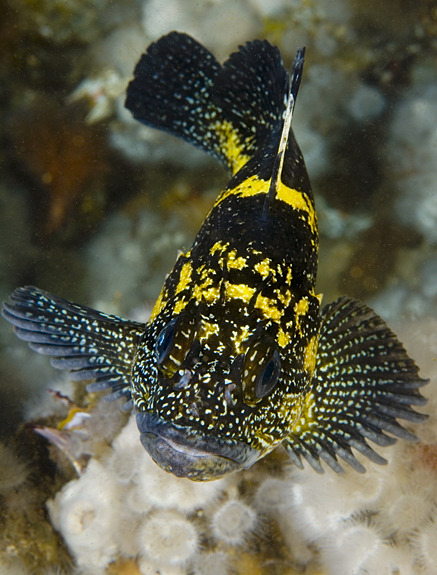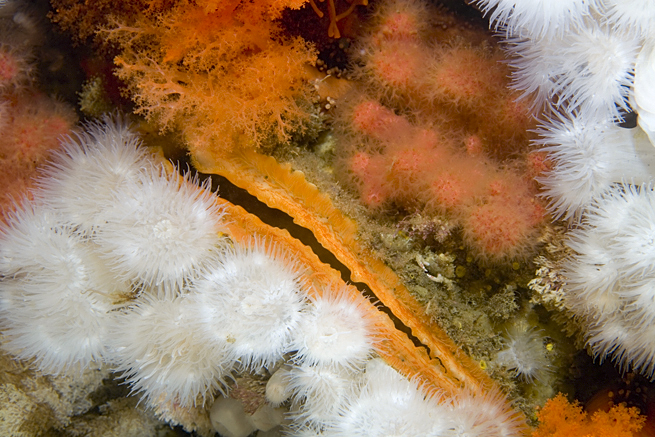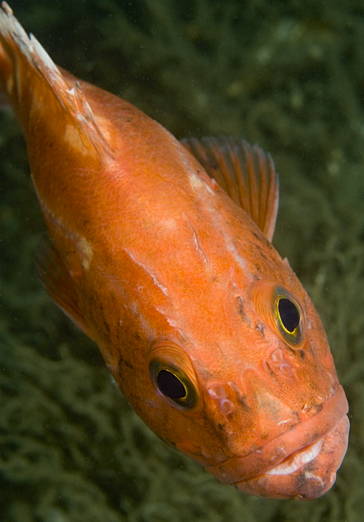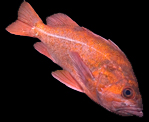
Arena Rock
Though Arena Rock is only a short, four hour drive north from San Francisco, it looks remarkably like British Columbia. It has walls blanketed in Metridium senile, and large, robust colonies of the beautiful and striking red soft coral, Gersemia rubiformis. Rockfish here include species much less frequently seen further south. In particular, one can't help but notice the healthy population of China and Yelloweye rockfish, both of which are quite photogenic. Even the geology here causes one to take notice. The rock is sedimentary, and as one descends, one repeatedly passes overhangs of ten or more feet. There are caves and swim-throughs, and, at least one impressive rock arch. Great!, so what's the catch? -- you knew there had to be one. Actually, there are a few. The first is logistical. One has to find a suitable launch. The closest launch is the Arena Cove pier. This is my preference, but it's a hoist launch which means that you have to own a lifting sling. The next best option is a launch from the Albion River. Getting into the river is no problem, but the elevation of the river's mouth is close to MLLW, so you need to plan your day around the tides. Albion is also about 20 nautical miles from Arena Rock, so you'll be in for a bit of a ride. This can be something of an ordeal as the weather around Point Arena often leaves much to be desired. Once you arrive at the site, you'll almost certainly notice that the rock itself breaks with frightening fury on all but the most ridiculously calm of days. I dove under the break once when the ocean was like a mill pond. It was quite pretty, but I don't think I'd be foolish enough to do something like that again. It was my first trip to Arena Rock, and I didn't have a full appreciation for what I was doing. There are various satellite rocks around the main rock. I've made all my dives subsequent to that first day on one of these. Even so, the boat still rests close enough to the break to make me more than little nervous. A glance at the rather long list of ships that have wrecked in this area would indicate that my unease is likely well-founded.

Though usually quite bashful, China rockfish (Sebastes nebulosus) may
occasionally be lured out into the open if one is careful to keep ones distance
and avoid any movement that could be construed as threatening. It took four
dives over two days to get this fish to come out from its crevice. This animal's
odd name derives from their popularity as a food fish among asians.
"Arena Rock", North Coast, California
June 4, 2006

Arena rock is just jam-packed with invertebrate life. The orange "lips" in this
picture are actually the mantle of a rock scallop (Crassedoma giganteum).
The bulbous clumpy soft coral is a sea strawberry (Gersemia rubiformis).
These contrast with the white of the anemone, Metridium senile.
"Arena Rock", North Coast, California
June 4, 2006

If you order "red snapper" on the west coast, you'll most likely get one of
these. Yelloweye rockfish (Sebastes ruberrimus), however, are a
remarkably poor choice of food fish due to their exceptionally slow rate of
reproduction. Amazingly enough, these fish can live to be well over a hundred
years old. That is, of course, unless they end up in your fish tacos instead.
"Arena Rock", North Coast, California
June 3, 2006

Home
